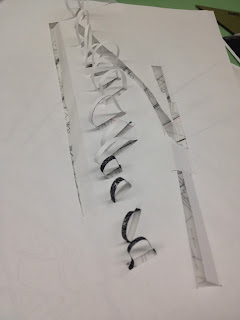The drawdel is a photo collage with significant pieces pulled up and pushed into the page. A perspectagonal photographic pop-up collage. No biggie. I'm using one photograph that specifically depicts the space and extends beyond the edges of the photograph to engulf the page in the space. I unsuccessfully tried working out another way to represent the trees. I'm not a fan of it, so I am trying something else. Just for the record, this is the unloved attempt:
The 3d drawing (the one I was more lost in) is a plan in perspective layered with a perspective layered a third time with significant sections. I'm using different line weights to depict the different layers with a particular emphasis on the section. Because the space I'm mapping reverses the angles of the graves, it is important to depict the vertical, physical, opening up of the space in context with the width of the plan.
-a








